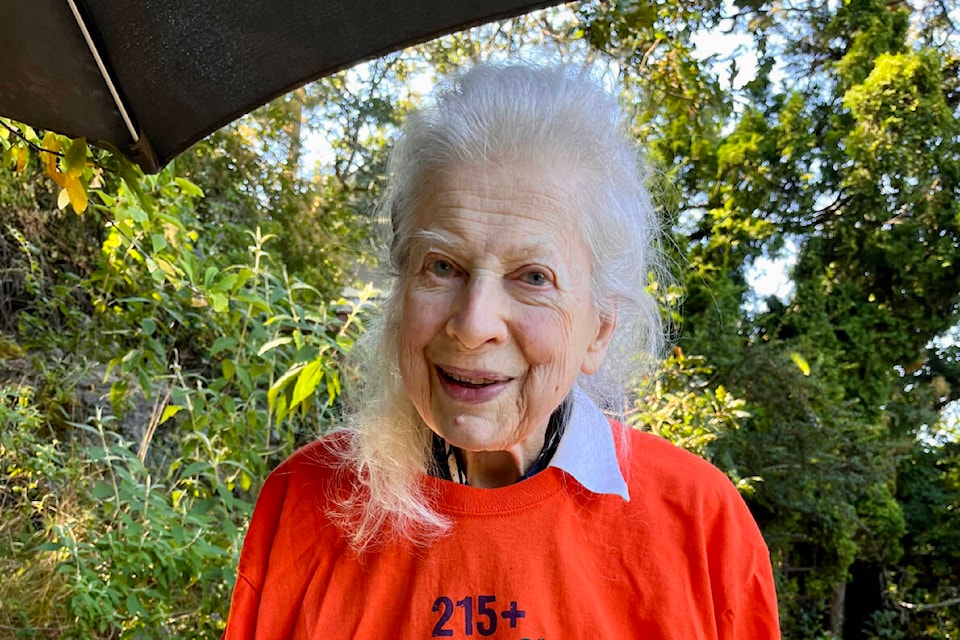The loss of Oak Bay artist, environmentalist and activist Marion Cumming leaves an impact that ripples through the community and beyond.
Cumming died peacefully at home the morning of Aug. 1, surrounded by friends and loved ones, said Arifin Graham, who was among them.
Born in Toronto in 1936, Cumming turned 86 on July 26. She and her late husband Bruce lived in Ontario and New Brunswick ahead of the last three decades in Greater Victoria. Bruce died in 2008.
Everywhere they lived, the couple made a significant difference in the community around them, Graham said.
After discovering they lived on unceded territory, Marion and Bruce donated their New Brunswick farm to the Maliseet in 1992.
“Aunt Marion was spirited, strong, passionate and loving. She recharged my sense of love every time I saw her,” said nephew Angus Macfadyen in a message from his UK home.
Cumming also donated a small cabin on land near the Koksilah River to the Victoria Native Friendship Centre and last year, bequeathed her Sunny Lane home to the centre upon her death. At the time, Cumming told the Oak Bay News she hoped the move would inspire others in similar simple acts of reconciliation.
“The treaty process is so slow and so contentious,” she said at the time, emphasizing there are ways to return lands.
Cumming was both a kind neighbour and an engaged resident with the district’s heritage foundation and was instrumental in returning First Nations history and recognition to the community, Oak Bay Mayor Kevin Murdoch said.
She worked closely with local archives and artists to create a trail of monuments that highlight history in what is now Oak Bay. Unveiled in 2009, the monuments feature artwork by Salish artist Charles (Temosen) Elliott.
“She was a doer,” Murdoch said. “There are a lot of permanent memories of her in our community that you can tangibly see, but she was also just really passionate about heritage, music and arts as well.”
Cumming also worked in those areas quietly and behind the scenes.
Bequeathing her final home only took centre stage in the media and community because executive director Ron Rice convinced her awareness would further the impact of reconciliation.
“She didn’t do any of this for any kind of recognition for herself. She always saw the cause as the most important thing,” Rice said.
RELATED: Oak Bay artist leaves land to Victoria Native Friendship Centre
Cumming called her little patch of land on Sunny Lane, Chikawich Sacred Land – out of respect for burial sites on nearby Gonzales Hill and Chikawich (McNeill Bay) and the people who lived there long before colonization.
“There are people in this world who get things done because they’re willing to invest their time and energy to see things through and she was one of those people,” Murdoch said. While the movements Cumming spurred will continue “her actual energy and passion and work ethic will be missed. There’s no replacing that energy.”
Ray Zimmermann met Marion and Bruce in the 1990s as part of a group concerned at the time over the Greater Victoria Water Board use of lands between Saanich Inlet and Sooke Basin. But Cumming’s work was about more than environment, he said.
“It’s much more than that. It’s holding people in positions of power, authority and responsibility, holding them to account for decisions,” Zimmerman said.
Asking informed, tough questions is how Rice remembers meeting Cumming (though he admits she remembered an even earlier meeting at a poetry reading). Rice was serving as moderator for an Indigenous law panel during a University of Victoria conference, where Cumming asked aloud why UVic didn’t return some of its many acres of land to the Peoples who previously inhabited it. The panel of Indigenous lawyers didn’t have an answer, but Rice sought her out afterward for conversation.
After bumping into each other at events and town halls they became more acquainted four and half years ago when he started working at the centre.
Cumming’s artistry stands out as strong as her advocacy, Rice said. “She wouldn’t take no for an answer. She has moved the needle for us that way, but then you couple that with her very beautiful and expressive protest art.”
Primarily a watercolourist, Cumming captured a sense of community, passion and emotion conveying it to prints. Her latest works focused on those battling to end old growth logging in the Fairy Creek Watershed.
“I have to imagine her spirit was satisfied with the work, the things she and her husband were able to accomplish in their lifetime,” Rice said. “May she rest in peace knowing we’re going to put her house to work. I hope she feels comfortable to come visit us once in a while.”
Lawyer Murray Rankin, the MLA for Oak Bay- Gordon Head who also serves as Minister of Indigenous Relations and Reconciliation, said he took delight in discussing with Cumming issues related to environmental and Indigenous cases.
“She was always a tremendously respectful companion for everyone she knew and worked with. Her firm moral compass guided her in all she did to enhance our collective commitment to nature, and to seek justice for Indigenous Peoples nationwide,” Rankin said in a statement to Black Press Media.
“Her passionate commitment was reflected in her enormous library, full of books on Indigenous rights, arts, and culture. Perhaps her most generous act of love was to donate her south Oak Bay home to the Victoria Native Friendship Centre on her passing. She was truly a wonderful advocate, friend, and a great Canadian. I will miss her dearly.”
A memorial is expected to take place in October, and the public will be notified.
